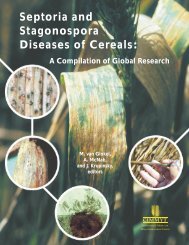appendices
appendices
appendices
You also want an ePaper? Increase the reach of your titles
YUMPU automatically turns print PDFs into web optimized ePapers that Google loves.
Appendix 4. Project summary<br />
Testing market segmentation of seed<br />
for agricultural development in Africa<br />
Justification<br />
Growth and development in Africa depend acutely on our ability to promote rapid productivity increases in the<br />
region’s agriculture. These productivity gains depend primarily on the ability of small-scale, resource-poor farmers<br />
to purchase modern inputs such as improved seed and fertilizer.<br />
Often, it is the high cost of improved seed marketed by private companies that challenges small farmers.<br />
However, without a viable and competitive private seed industry, small farmers are unlikely to gain access to<br />
improved seed.<br />
The challenge for Africa is to develop mechanisms that encourages farmer adoption of new technologies and<br />
supports the growth of private investment in seed markets. A combination of development- and market-oriented<br />
interventions can potentially achieve this, provided it simultaneously addresses the interests of small farmers and<br />
seed companies.<br />
Objective<br />
The objective of this project is to explore viable market-based mechanisms that would increase small farmers’<br />
access to improved seed and growth of a competitive seed industry.<br />
To do so, the project will develop and test a market segmentation strategy for the Kenyan maize seed market that<br />
simultaneously lowers the cost of improved seed for low-income farmers and encourages growth of a competitive<br />
seed industry.<br />
Figure 1. Maize agroecological zones and the poor.<br />
Principle<br />
The key principle here is to maximize the benefits for low-income farmers of using improved seed while<br />
minimizing the costs of distributing improved seed to them, and minimizing the distortions to the competitive<br />
market for improved seed.<br />
Options<br />
The challenge identified here can be approached in several ways, for example, by exploring alternative<br />
distribution mechanisms such as:<br />
• Direct distribution: Selected farm households in the project area are provided with a set quantity of seed (5-15<br />
kg) at some discounted price. The project distributes the seed directly.<br />
• Tiered pricing: All farm households in the project area could be allowed to purchase a set quantity of seed (5-<br />
15 kg) at some discounted price. Private seed stockists sell the seed directly.<br />
• Voucher distribution: Selected farm households in the project area are issued vouchers that provide them with<br />
the right to purchase a set quantity of seed (5-15 kg) at some discounted price. Private seed stockists would<br />
sell seed directly.<br />
56









